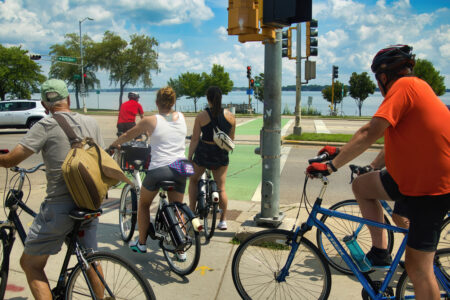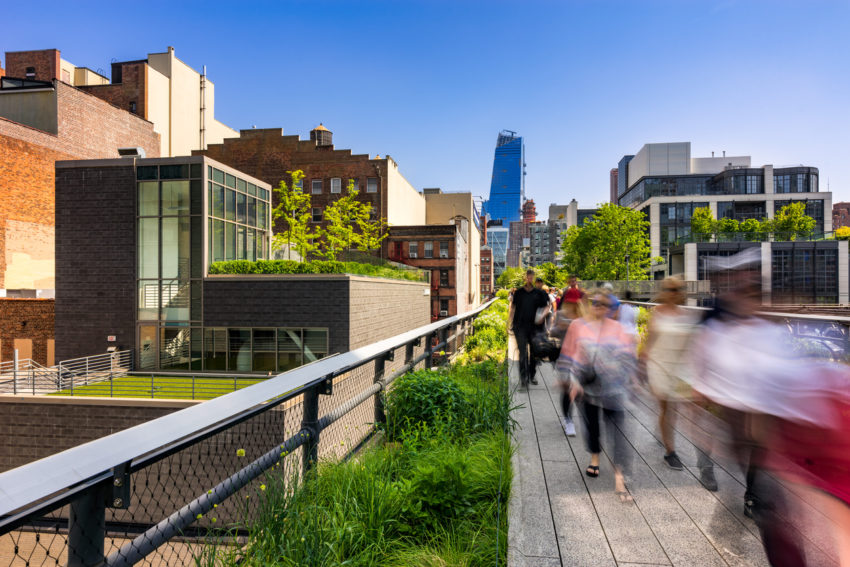
Share On Social!
This is part of the Salud America! The State of Latinos and Housing, Transportation, and Green Space: A Research Review »
Summary
To improve access to affordable housing near public transport, Latinos would benefit from transport-oriented development projects in their neighborhoods that increase the stock of affordable housing centered around the transport hub. These projects should emphasize strong preemptive community involvement to limit displacement and gentrification that has frequently plagued these projects, and to maintain cultural authenticity in Latino neighborhoods that have undergone revitalization.
What Is Transit-Oriented Development?
Transit-oriented development is a model for neighborhood revitalization that can be defined as ‘walkable, dense, compact, mixed-use development in close proximity to high-quality transit [50].
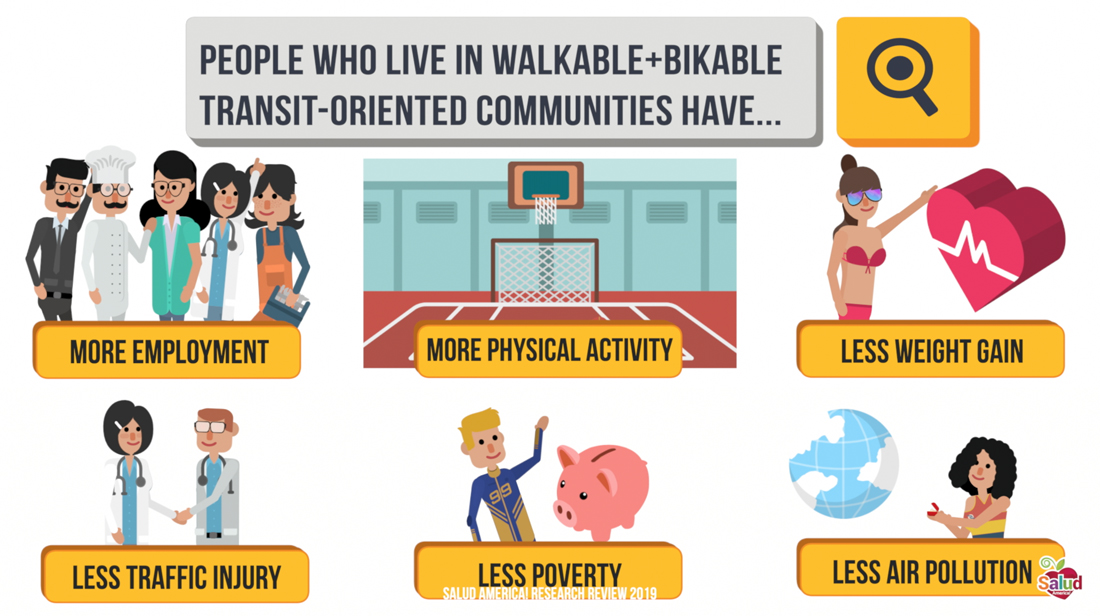 Office, residential, retail, and civic uses are in close proximity around a central transit hub, and high-density, high-quality housing surrounds the transit hub within a 10-minute walking radius.
Office, residential, retail, and civic uses are in close proximity around a central transit hub, and high-density, high-quality housing surrounds the transit hub within a 10-minute walking radius.
The general goals of transit-oriented development are to [50]:
- Increase “location efficiency” so people can walk, bike, and then take public transit
- Boost transit ridership and minimize traffic
- Provide a rich mix of housing, shopping, and transportation choices
- Generate revenue for the public and private sectors and provide value for both new and existing residents
- Create a sense of place
Mixed-Income Housing Is Key for Transit-Oriented Development
An important aspect of transit-oriented development is mixed-income housing, which limits income segregation and allows low-income households easy access to public transit.
Low-income housing is incorporated in a deliberate effort to limit displacement and to increase the vibrancy of the community [50]; without maintenance or expansion of affordable housing stock, transit-oriented development projects in Latino communities have been historically detrimental [18].
Because developers often resist building affordable housing, potential strategies for enticing them to do so include use of low-income housing tax credits (LIHTC), creation of a public land disposition plan (city-owned land provided at low/no cost if used to build affordable housing), fast track permitting, fee waivers, and inclusionary zoning [50].
Once built, maintaining the affordability of housing over the long-term becomes the challenge, as development often leads to real estate appreciation and gentrification.
Retaining Latino Residents amid Neighborhood Revitalization, Transit-Oriented Development
However, gentrification is not an inevitable result of investment in low-income Latino neighborhoods.
Several case studies have shown that when development is informed by the community’s voice and influenced by local activism, long-time neighborhood residents can benefit from these revitalization projects.
Looking at large-scale transit-oriented development projects in low-income Latino neighborhoods that have successfully limited displacement, maintained their Latino identity, and satisfied the community’s needs and desires have highlighted four conditions that when met, improved the quality of life for the Latino residents of the community [13, 14]:
- Building affordable housing (beyond the amount originally planned by the developers)
- Supporting or establishing Latino culturally relevant public spaces
- Investing in community-based public arts
- Collaborating with activists in the neighborhoods to make the transit-oriented developments more community-oriented
In-depth study of four large-scale transit-oriented development projects in four Latino communities demonstrates that the most essential element to success at limiting displacement and gentrification was expansion of affordable housing [13, 14].
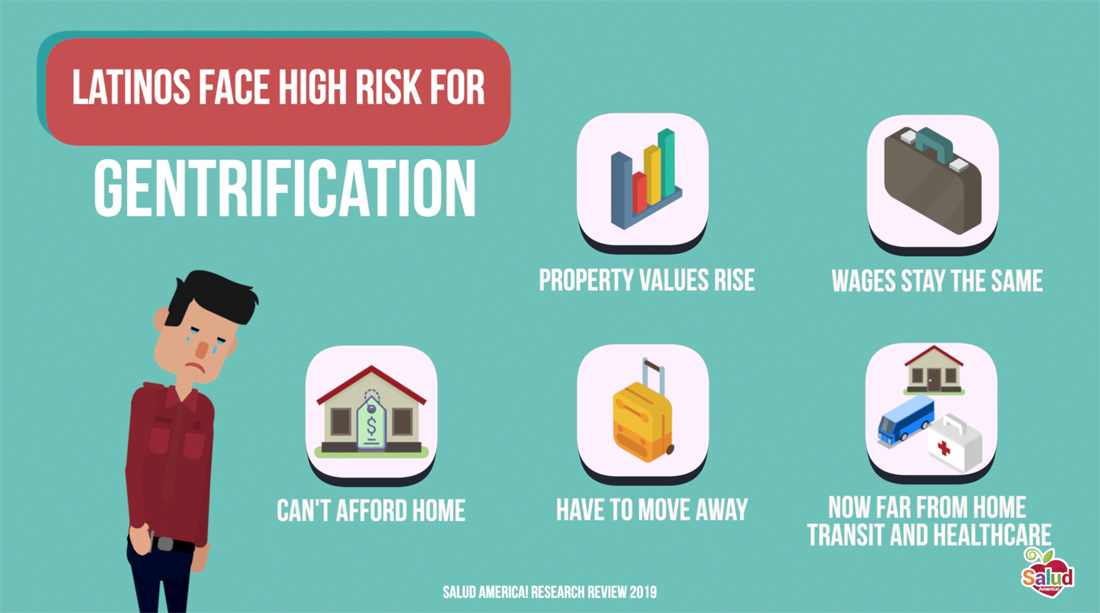 In each case, this was accomplished through community involvement with the development process—current neighborhood residents joined together to demand affordable housing, and they would stall development if it was not provided. In each case, local Latino politicians or community groups served as “champions” for the projects and used their political capital to make sure the plans were implemented as agreed [19, 51]. As one of the study authors, Sandoval, states:
In each case, this was accomplished through community involvement with the development process—current neighborhood residents joined together to demand affordable housing, and they would stall development if it was not provided. In each case, local Latino politicians or community groups served as “champions” for the projects and used their political capital to make sure the plans were implemented as agreed [19, 51]. As one of the study authors, Sandoval, states:
“All four barrios analyzed point to resistance and activism as being important features in these barrios. All these TOD [transit-oriented development] projects have run into some form of neighborhood resistance. This is because urban and transportation planners have not paid close enough attention to public participation issues and to tailoring these projects to benefit current residents.
“In the MacArthur Park case, resistance came from Supervisor Gloria Molina and neighborhood activists who pushed the MTA to go back to the drawing board and develop a TOD that was more in tone with the neighborhood context.
“In the Fruitvale Transit Village, the Spanish Unity Council stopped BART from building a large parking structure that would cut off International Boulevard (and hence the neighborhood) from the BART station. Instead, the Unity Council took over the development of the TOD and now it has become a model of doing TOD in low-income neighborhoods.
“In Barrio Logan, neighborhood activists demanded that the Mercado Del Barrio Apartments be designed as affordable housing instead of market rate housing before the project could be approved.
“And in Boyle Heights…one key neighborhood activist organization sprung up from these struggles, Union de Vecinos. This organization became one of the key organizations working on tenant housing rights in the area and now still organizes around anti-gentrification struggles. The organization is a grassroots organization and its founders emerged from faith-based communities in the neighborhood. They were key players in making sure tenants either received relocation assistance or could come back to the new development” [19].
Though the transit-oriented developments in the majority-Latino neighborhoods of MacArthur Park, Los Angeles; Fruitvale, Oakland; Boyle Heights, Los Angeles; and Logan Heights, San Diego were each quite different in their concept, each received and responded to community input that affordable housing be added.
One particularly interesting transit-oriented development example is MacArthur Park, Los Angeles.
Though the development now has many of the amenities that draw wealthy urbanists, the original community was not displaced because of the key role affordable housing played in its development.
Adding Latino-Focused Amenities to Transit-Oriented Developments
Other services incorporated in the development also offer positive equity impacts, as the Fruitvale development includes health care, child care, a city library, a senior center, and a charter high school [13].
An important and interesting point is that the neighborhood resistance and activism in each of the 4 TOD areas have in fact dictated the types of community benefits that emerged from the projects [14].
As Sandoval states, “The important role activists played in the transformation of the TOD from a market rate housing development project to an affordable housing development project is key to understanding how these TOD projects can have equitable outcomes in low-income areas” [14].
Investing in Latino placemaking is defined as creating a culturally relevant Latino public space to spur vibrancy in the neighborhood. In Boyle Heights, Los Angeles, this was done by creating Mariachi Plaza that brought a kiosk in from Mexico. This plaza serves as a community center to host music festivals, urban farmers markets, lowrider car shows, and other social and cultural events. Importantly, it has also re-activated and contributed to economic investments along the main commercial street in the area, because residents from other areas of the city travel to the plaza to enjoy the special events held there.
In Logan Heights, San Diego, Chicano Park has served as the culturally relevant central space that has both historic and artistic importance for the community [14].
Adding Latino-Focused Public Art to Transit-Oriented Development
Murals play a large role in Latino culture and placemaking.
In both Boyle Heights and Logan Heights, planners commissioned local artists to provide public art at their development. In doing this, representations of the everyday lived experiences, both historic and present, as well as the cultural aesthetic of current residents were represented and respected.
As Sandoval writes, “The design team incorporated murals into the project, built a plaza, and encouraged a supermarket, Northgate, that caters to a Latino niche retail market” [14]. These actions responded to community demands and allowed the project to move forward with resident support.
Forming a Community Group to Protect Neighborhood Interests
Because Chicano park is ingrained with political history, it is protected by local activists, which represents a strong supply of political capital from the community.
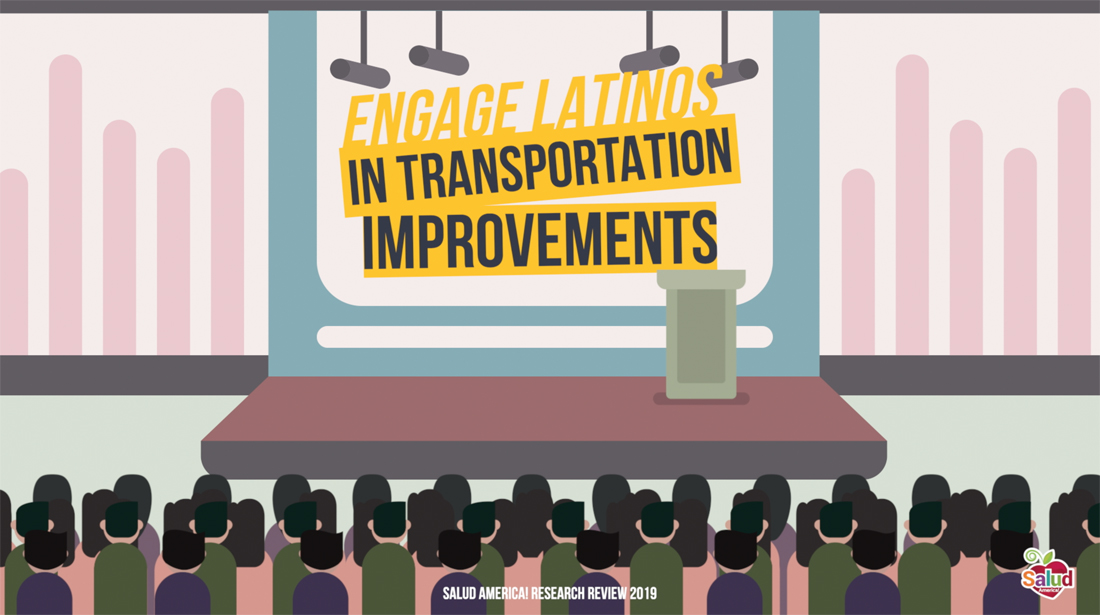 Neighborhood organizations including the Environmental Health Coalition, the Chicano Park Steering Committee, and the Barrio Station Committee can be called upon at any time to organize if there are threats to the neighborhood, or if further development is being considered.
Neighborhood organizations including the Environmental Health Coalition, the Chicano Park Steering Committee, and the Barrio Station Committee can be called upon at any time to organize if there are threats to the neighborhood, or if further development is being considered.
This form of political capital is a great strength to the community, and serves as a form of resistance to the pressures of gentrification and neighborhood turnover [14, 33]. In the face of revitalization projects, many community organizations emerge from faith-based organizations or from professional organizations and can persist for years to come, providing the community with political capital and strength to leverage in the face of external threats.
When transit-oriented developments are able to expand the stock of affordable housing, establish culturally relevant Latino public spaces, invest in community-based public arts, and collaborate with local residents to make developments as community-oriented as possible, there is a strong chance they will be successful at limiting displacement and providing benefit to the current residents.
Quick links from our Research Review »
SEE the TRANSPORTATION FACT SHEET!
More from our Research Review »
- Executive Summary
- Introduction & Methods: Latino Housing, Transportation, and Green Space
- Research: Latino Families Burdened by Housing Costs, Eviction
- Research: Latino Rural Migration Led to Housing, Transportation Inequities
- Research: Latinos Face Big Public Transportation Challenges
- Research: Latino Communities Lack Accessible Green Space
- Strategy: How to Increase Affordable Housing in Latino Communities
- Strategy: How Transit-Oriented Development Benefit Latinos
- Strategy: Improve Public Transit to Improve Latino Quality of Life
- Strategy: Green Space Projects Can Boost Latino Health
- Strategy: Latino Community Involvement Can Spur Environmental Justice
- Policy Implications: Latino Housing, Transportation, and Green Space
- Future Research Needs: Latino Housing, Transportation, and Green Space
References for this section »
13. Sandoval, G. F. (2015). Transit Oriented Development and Equity in Latino Neighborhoods: A Comparative Case Study of MacArthur Park (Los Angeles) and Fruitvale (Oakland). National Institute for Transportation and Communities. Retrieved from https://pdxscholar.library.pdx.edu/cgi/viewcontent.cgi?article=1064&context=trec_reports
14. Sandoval, G. F. (2016). Making Transit-Oriented Development Work in Low–Income Latino Neighborhoods: A comparative case study of Boyle Heights, Los Angeles and Logan Heights, San Diego (pp. 1–74). National Institute for Transportation and Communities.
18. Joassart-Marcelli, P., Wolch, J., & Salim, Z. (2011). Building the Healthy City: The Role of Nonprofits in Creating Active Urban Parks. Urban Geography, 32(5), 682–711.
19. Frey, W. H. (2010). Census Data: Blacks and Hispanics Take Different Segregation Paths, in State of Metropolitan America. Brookings: Brookings.
33. Carter, E. D. (2016). Environmental Justice 2.0: new Latino environmentalism in Los Angeles. Local Environment, 21(1), 3–23. doi:10.1080/13549839.2014.912622
50. U.S. Department of Housing and Urban Development. (2012). A Model Housing Transportation Plan: Coordinating Housing and Transportation.
51. Stodolska, M. (2011). Perceptions of Urban Parks as Havens and Contested Terrains by Mexican-Americans in Chicago Neighborhoods. Leisure Sciences, 33(2), 103–126.
By The Numbers
27
percent
of Latinos rely on public transit (compared to 14% of whites).


